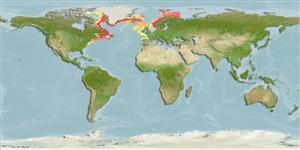Preferred temperature (Ref.
123201): 1.1 - 5.4, mean 3.2 °C (based on 330 cells).
Phylogenetic diversity index (Ref.
82804): PD
50 = 0.5000 [Uniqueness, from 0.5 = low to 2.0 = high].
Bayesian length-weight: a=0.00224 (0.00139 - 0.00361), b=3.22 (3.08 - 3.36), in cm total length, based on LWR estimates for this species & Genus-body shape (Ref.
93245).
Trofisk nivå (Ref.
69278): 3.9 ±0.56 se; based on food items.
Resiliens (Ref.
120179): Mycket låg, lägsta populationsfördubblingstid mer än 14 år (Preliminary K or Fecundity.).
Fishing Vulnerability (Ref.
59153): Moderate to high vulnerability (50 of 100).
Nutrients (Ref.
124155): Calcium = 18.4 [9.8, 38.2] mg/100g; Iron = 0.33 [0.17, 0.64] mg/100g; Protein = 16.8 [14.0, 19.0] %; Omega3 = 0.238 [0.122, 0.463] g/100g; Selenium = 23.8 [9.5, 61.0] μg/100g; VitaminA = 9.9 [2.1, 48.4] μg/100g; Zinc = 0.385 [0.255, 0.592] mg/100g (wet weight);
